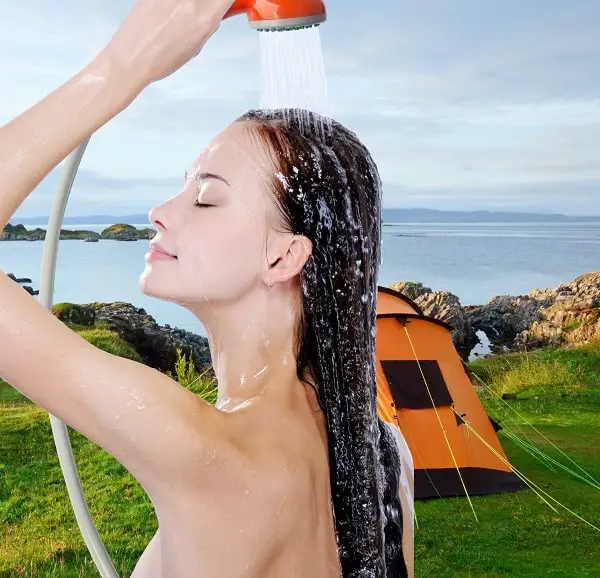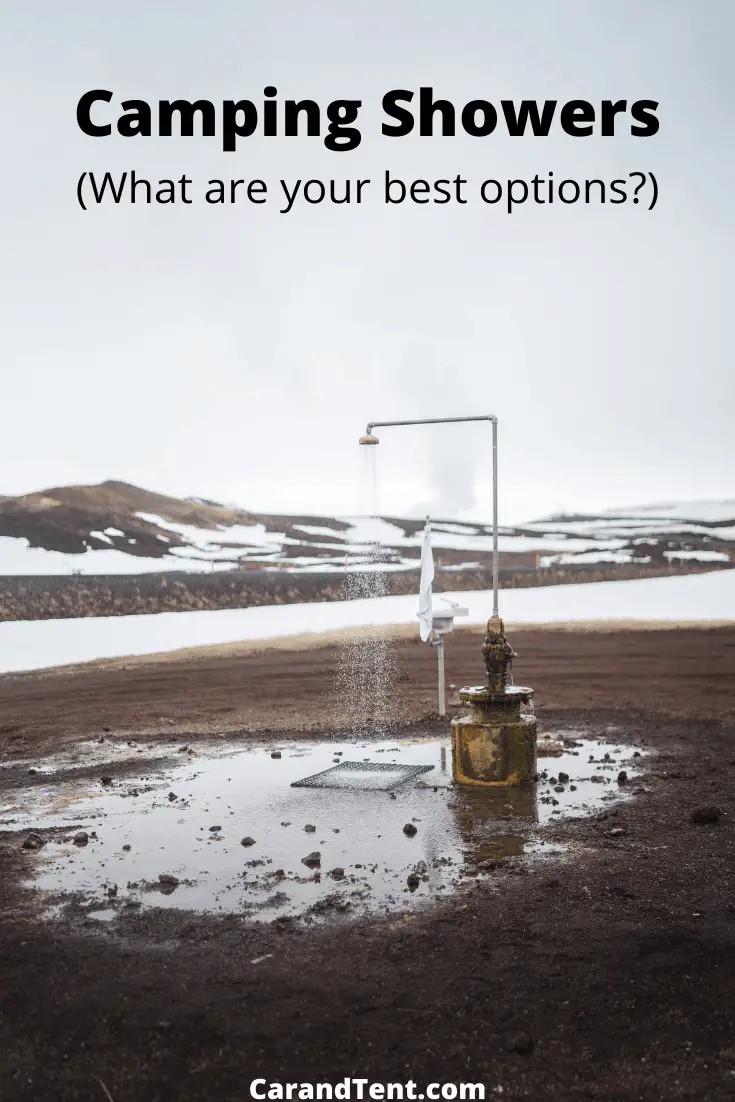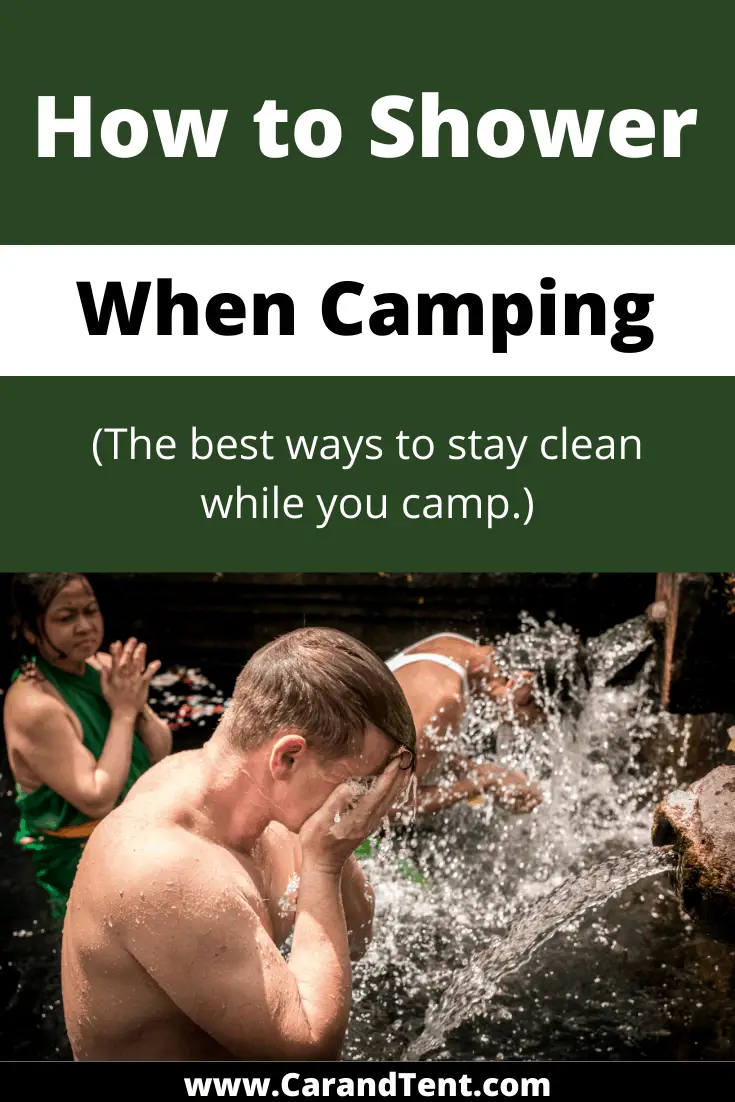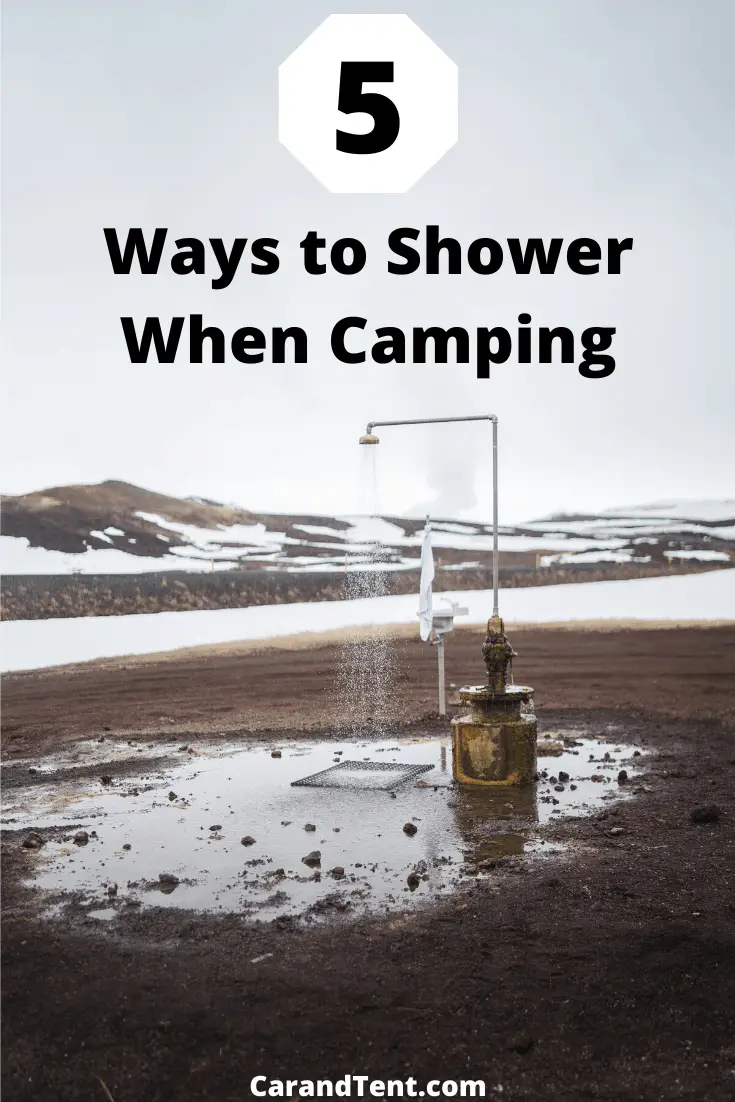How to shower when camping is one of the most asked questions of new campers. It’s a logical question and one that isn’t always simple. Sometimes a shower is possible and sometimes it isn’t but either way, it’s important that you stay clean.
In this post, I’ll talk about how to shower when camping and how to stay clean when you can’t shower while camping.
Here are some areas we’ll cover.
- Finding a park or campground with showers.
- Choosing and using a camp shower.
- Taking a sponge bath.
- Hygiene tents.
- Keeping clean without taking a shower.
- Leaving no trace.
- Personal hygiene and safety.
Table of Contents
Take a Real Shower
Many state parks, national parks, and campgrounds have real showers for you to use while camping. These are often located in the car camping areas of the park but wilderness campers could periodically hike back to the park to take a nice hot shower from time to time.
Some of these showers are free and some will require you to pay a small fee so be sure to have some cash on you when you hike back to the bathrooms. Also, be sure to bring shower shoes as these bathroom floors can hold a lot of bacteria.
You’ll find that some parks have really clean bathrooms and others look like they haven’t been cleaned in years. Personally, I’ve walked into showers that were so dirty that I wasn’t sure I felt any cleaner when I left than when I had gone in.
How to Find a Park with Showers
Most states will have a list of amenities on their websites so it’s easy to find parks that have showers in them. Pennsylvania’s state park system has a nice little chart that lists all of the state parks by region.
The state parks that feature showers have a little image next to them so you can see in an instant which parks have showers and which don’t.
How to Use The Showers
If you’re car camping, you’ll be able to pack anything you want to shower with so I’d recommend at a minimum, you bring:
- Shower shoes.
- Towels.
- Washcloths.
- Soap.
- Shampoo.
Car campers also have the luxury of being able to drive out of the park to take real showers. If the park you’re in doesn’t have a bathroom with showers, you could always take a trip to a truck stop, fitness center, or even a local beach with shower facilities.
Backpackers might want to skip the soap and shampoo and go with a biodegradable soap that can be used in the bathhouses as well as in the wild. This is especially true if you’re doing a multi-day backpacking trip and you’ll be passing by state parks rather than parking at them.
Of course, if you are parking at a state park and just venturing a few miles out, you could always store your shower gear in your car and just take it out when you need it.
Taking a Camp Shower
There are a wide variety of camp showers you can use at car camping sites and even on backpacking trips. Car campers will have more options to choose from but backpackers also have some options for showering out in the wild.
Here are some of the camp showers that are currently available.
- Portable handheld showerheads.
- Propane-fueled showers.
- Solar showers.
Portable Handheld Showerheads
A portable handheld showerhead is essentially a showerhead with a hose that runs to a submersible water pump. These are great because you can just drop them in a bucket of water and they’ll pump water up from the bucket and through the showerhead.
The larger the bucket you use, the more water you’ll have to shower with. Heat water up in a pot over your campfire and you’ll have hot water to shower with.
The pump is battery powered and you can buy pumps that run on rechargeable batteries and pumps that run on replaceable batteries. Some portable showerheads can even hook up to the 12-volt jack in your car.
Example of Portable Showerhead
The Iron Hammer Portable Shower – This portable shower is a little over 1 pound in weight and takes two rechargeable lithium batteries. These batteries can power the portable shower for more than 60 minutes.
The shower is charged with a USB-DC cable and the hose on the shower extends up to 82 inches in length. This shower packs down small enough that you could technically bring it backpacking but I’m not sure that I would recommend it unless you’re traveling with a group that will be sharing it as it will take up space in your backpack.
However, I do think this shower would be great for car camping trips. You can even use it to help you wash off your gear outside on an apartment patio or somewhere else where you don’t have access to a garden hose.
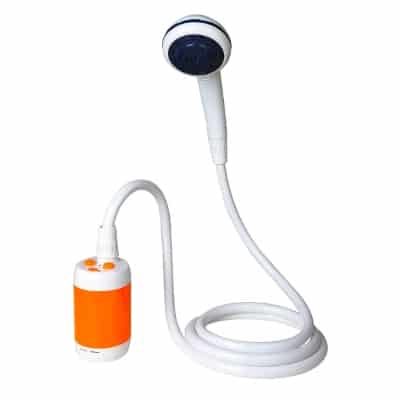
Propane Camp Showers
Propane-fueled showerheads work in a similar fashion to the battery-powered handheld showerheads but they use a propane heater to heat the water up for your shower. These showers use small propane canisters so you won’t have to worry about dragging a large propane tank out to your campsite but you will have to refill the canisters more often.
Personally, I think it is just easier to heat up water over a campfire or camp stove but if you have a lot of room to spare you might want to consider packing a stand-alone propane shower.
Example of a Propane Camp Shower
The Zodi Outback Gear Hot Tap Travel Shower – This propane shower attaches to a 16-ounce propane cylinder or a 5-gallon propane tank so you could take it wilderness camping or use it alongside your propane grill.
The case doubles as a 4-gallon water tank which the company says will allow the shower to operate for 10 minutes. The shower hose on this unit is 8 feet long and the water pump runs off of a 6-volt power supply.
60 gallons of water can be heated up before you need to refill the small propane canister and charge the battery.
This camp shower might be a good car camping solution but I can’t imagine taking a 4-gallon tank with me on a backpacking trip.
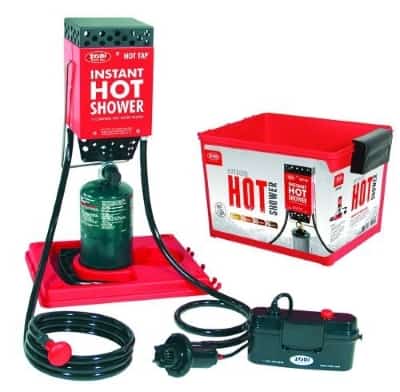
Solar Showers
While propane camp showers and portable showerheads are best left to car campers, solar showers can easily be used on any type of camping trip. A solar shower is typically just a bladder that can hold a couple of gallons of water.
This bladder will have a showerhead built into it that works with gravity to pour the bladder’s water content onto you. These showers aren’t pressurized but you’ll still get to enjoy the sensation of a warm shower pouring over you.
The solar shower water is heated within the bladder when you lay it out in the sun. The longer you leave the bladder in the sun, the warmer your shower will be. Theoretically, you could also fill the bladder up with warm water on days without sun.
I like these types of showers because they pack down small and you can take them anywhere. The two drawbacks to them are that you have a limited amount of water to work with and you do not get a pressurized shower.
Example of a Solar Shower
The Advanced Elements Summer Solar Shower – This camp shower holds up to 3 gallons of water and has a built-in temperature gauge so you can tell when it is warm enough to use. The sides have pouches built into them for storing small items like travel soap and shampoo bottles.
When not in use, the solar shower can be rolled up to fit easily into your backpack.
Solar showers like this are great for backpacking trips or even boat and car camping trips when space is limited. As long as you have water and you’re someplace sunny you’ll have a nice warm shower to look forward to each day.
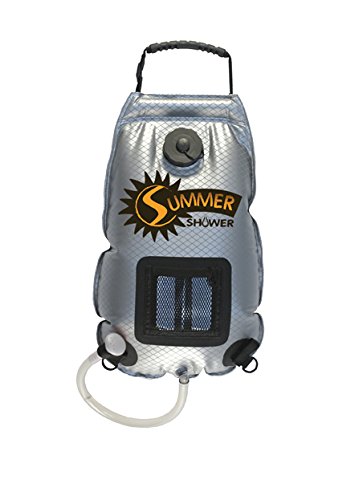
Sponge Baths
Portable showers are great for places that offer up a lot of water. Unfortunately, they aren’t very useful for backpackers or even car campers camping in places where access to clean water is limited. This doesn’t mean you have to skip cleaning your self though.
When water is limited, consider taking a sponge bath. Sponge baths require very little water and they can often leave you just as clean as a regular shower would.
How to Take a Sponge Bath
- Fill a bucket or small container up with warm water.
- Use a sponge or washcloth to apply water to your body.
- Lather yourself up with soap while focusing on scrubbing areas that tend to get dirtier.
- Clean off your washcloth or get a new one and use it to apply non-soapy water to your body.
- When all of the soap has been removed, dig a hole 200 feet away from the nearest water source and dump the remaining suds into it.
Some people will use two small water containers while sponge bathing. They’ll use one to apply water and then soap and another one to apply water to their now clean body.
Try taking a sponge bath at home before you shower so you can get a feel for what it might be like out in the wild.
Hygiene Tents
When you’re washing up in a campground or even in the wilderness, you might want to use a hygiene tent to cover up. These are tents that are meant for walking into and standing up in but not much else. They don’t take up a lot of space as they typically have dimensions of about 4’x4′.
Also, these tents generally won’t have a floor so water can run directly into the ground. These tents are good for showering in as well as for storing portable toilets. When you’re planning on taking a shower at your car camping site, a hygiene tent is essential.
When wilderness camping, you might not want to pack an entire hygiene tent with you. In this case, you could bring a tarp and some rope to make your own privacy screen.
Alternatively, you could just wear a bathing suit and bathe without actually taking it off. This could be an easy alternative for when you’re car camping around strangers and you don’t have a privacy tent or tarp to make one.
Example of a Hygiene Tent
The WolfWise Portable Pop-up Tent – This tent is about 4.5 pounds and it opens up to 47″x47″. It stands about 75″ tall and has an open floor. Technically, taller campers could dig out the floor a bit to give themselves some extra standing room.
There are pouches inside as well as a clothesline so you can store your valuables and put up a towel inside the tent. Ventilation windows are also built in so you can open them up to allow the tent to dry out quickly afterward.
Tents like these are good for camping trips that don’t involve a lot of backpacking. Boat campers and car campers might want to consider getting something like this to take private showers in.
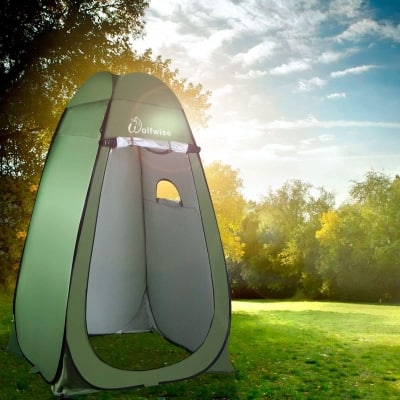
Keeping Clean Without Taking a Shower or Bath
Sometimes water and backpack space are so scarce that taking a shower or even a sponge bath just isn’t an option. Again, this doesn’t mean you can’t keep clean. Facial wipes and baby wipes can help you sanitize yourself and body powders can help you keep dry during long days of hiking and camping.
To help avoid breakouts on your face, shave at night after you’ve washed up for bed. Your pores will be wider and you’ll have an easier time shaving with less irritation to your skin as a result.
Following No-Trace Procedures
Personal hygiene is great for people but it can wreak havoc on the environment. Sources of water are especially vulnerable to soap and shampoo and you should never bathe in a stream, pond, or lake.
Just because a container of soap is labeled non-toxic or biodegradable, doesn’t mean it is safe for the environment. According to the EPA, one ounce of biodegradable soap needs to be diluted by about 20,000 ounces of water for it to be safe for fish.
To keep your favorite wildlife areas safe, always follow no-trace procedures when engaging in any personal hygiene activities.
Here is what you’ll want to do when showering in the wild.
- Use biodegradable soap.
- Shower at least 200 feet away from a water source.
- Bury your soapy water when possible.
Biodegradable soap will eventually break down in nature and become harmless. Unfortunately, this doesn’t happen right away so it is best if this soap is filtered through the soil before it reaches a water source.
If this soap does reach a water source, it can feed a lake’s plant life causing an explosion of algae and other plant weeds that will eventually deprive the lake of oxygen and cause the local fish to die off. This causes a chain reaction and many other species of wildlife can end up dying off as well.
But don’t plants produce oxygen? Yes, plants produce oxygen but they can also consume it from water through respiration. The process is somewhat technical for an outdoors website but you can read more about it at https://aquaplant.tamu.edu/faq/dissolved-oxygen/.
Personal Hygiene and Safety
Did you know that bears and other animals can be attracted to the scent of your soaps, deodorants, lotions, and other personal hygiene products? While it might be unlikely, a bear might even rip through your campsite just because he smelled your lip balm or toothpaste.
When camping, put these items in your bear canister and hang the canister in a tree or put it the recommended distance away from you. If you’re car camping at a state or national park, put these items in your food locker.
Backpacker’s resident bear even suggests that you skip the deodorant when camping overnight in bear country.
For myself, I just take along unscented personal hygiene products. You can buy these at most hunting stores. They help you stay both clean and safe from any animals who may otherwise decide that you smell delicious.
Related Questions
Do campsites have showers? A typical campsite will not have a shower on it but many campsites will have shower facilities within walking distance. However, many campsites will have water hookups that you can use to fill up your camping shower without having to leave your campsite.
You’ll know when a campsite has water available as it will say “full-hookup” or “water only”. Either of these options will give you a campsite with water.
How do you wash your face when camping? When primitive camping, the best option for washing your face is to use biodegradable soap or facial wipes. When camping at a campground with regular bathrooms, feel free to bring your usual soap and use the bathroom sink to wash your face.

